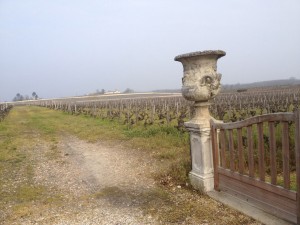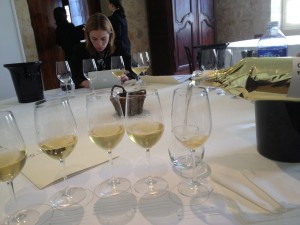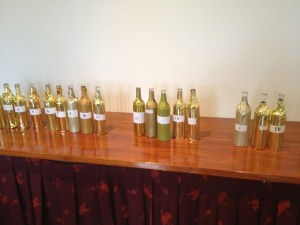Bordeaux 2012: Sauternes and Barsac face tough year
April 9, 2013
By all accounts, Bordeaux 2012 was not a simple year. Before we examine the wines of Sauternes and Barsac, a few words, generally, about the vintage.
Humidity in the Spring, dryness leading up to the harvest – thick skins on grapes that challenged vintners to wait for a later harvest (and risk picking in rainy conditions) – and other hurdles made it a ‘vintner’s harvest’. As Remi Edange of Domaine de Chevalier told me, it was not like 2009 or 2010.
Indeed, 2012 was the second straight difficult year in Bordeaux. The wet and cool start to the season led to an uneven flowering and reduced crop. The long dry stretch that ensued stressed the vines and led to uneven ripening: “Between 29 July and 22 August, we only had 13mm of rain,” said Patrick Maroteaux of Chateau Branaire Ducru, who classifies 2012 as a “very good year” compared to “exceptional” years like 2009 and 2010.
Still, the contrast of a wet start with drought-like conditions led to a very heterogenous veraison, with bunches showing mixed colored grapes into September. ‘And the grape skins were very thick,’ noted Remi Edange, assistant manager at Domaine de Chevalier. ‘We had to pick between 9 and 12 October,’ he said. Just before the official dinner to open the en primeur tastings for the wine media, Olivier Bernard – who is president of the Bordeaux Grand Cru Union (UGCB) stressed that he had to pick his white grapes in October.
Rains did fall in late September through late October, as seen in various harvesting photos. This created conditions for disease and forced some growers to pick under wet conditions.
Producers in sweet-wine producing areas of Sauternes and Barsac were no less challenged. In her harvest report, Marie-Stéphane Malbec noted that 2012 will be remembered ‘as a complicated year’ which often placed considerable strain on the nerves of growers in the region. The two months of summer without a drop of rain were not exactly ideal for botrytis to develop and localized rainfall led to a sluggish development of noble rot. Pickings did not start before October in many cases and what was most challenging were interrupting spells of rain that challenged vintners with less than noble rot and mildew. As Malbec noted, ‘every property, and almost every plot, was exposed to different weather conditions, making the harvests a complex affair. Each château had a window of opportunity to pick their grapes.’ But the windows were never very long lasting. Several chateaux, like Chateau de Fargues, made very small amounts of wine, and at least three – including Chateau d’Yquem, Rieussec and Raymond-Lafon, chose not to make any ‘first wines’…
Let’s start with some tasting notes for Sauternes and Barsac.
Tasted at Chateau Raymond Lafon: Jeunes Pousses (second wine).
Less concentration that normal and not quite as concentrated, still this wine has lovely aromas of white pear, pineapple and some fresh flower aspects, quite discrete. The palate is light when compared to previous vintages tried. Co-owner Jean Pierre Meslier explained that the estate decided not to make Raymond Lafon first wine because the concentration levels were not adequate enough for it. The last time the Meslier family did not make any (first) wine was in 1974. A clear indication that the vintage was a challenge. But for lovers of Sauternes, this lighter style will also translate no doubt into a lighter price.
Tasted blind in four flights of wine, at Chateau Coutet in Barsac on Monday 8 April (Numbers indicate the number of the bottle as we tasted according to number and not chateau; only after the tastings were the corresponding names revealed). Overall, these are vins d’apero for me, representing at their best a lighter style that retains elegance and refinement. Alas, some were a bit medicinal and heavy. Recall that barrel samples for Sauternes are not so easy to assess. It will be best to wait until we taste from bottle in a couple of years or so.
When in bold, I liked particularly, red and bold even more, and if underlined – the best.
Chateau Bastor Lamontagne: 88-90
1: Like the Jeunes Pousses tasted yesterday, this wine has somewhat light aromatics… and seems less concentrated. The palate has a fruit-driven attack, sweet fruit, and not cloying – overall leaving a “pretty” impression with adequate concentration. I like this one, as second best of the flight.
Chateau Romer: 88-90+
2: More subtle nose with white pear. The palate is rather suave, and the most elegant of this first flight. And less straightforward: more interesting. Fine. If a touch hot on the finish.
Chateau de Malle: 85-87
3: Some cinnamon spice but a bit of cloying pineapple on the nose. The palate is medicinal albeit not as much as wine number 5… Not sure about this one.
Chateau Suau: 86-88
4: This too is a bit too light on its feet for my taste, lacking substance – but I would say that it could be a fine aperitif drink. Flavors of suggested nutmeg, spice, with white floral aspects, and white fruit. If the price is right, why not? Not cloying but not very focused either.
Chateau Nairac: 85-87
5: More spice here on the nose. The palate has good “stickiness” … I like the attack. There is a sort of medicinal aspect that detracts, but not the worst of the bunch. Somewhat abbreviated on the finish. Not sure.
Flight two
Chateau Broustet: 87-88+
6: Darker color. A bit of reduction here, exuding some matchstick aspects. Like others, not very clear. But the nose is very rich and nutmeg like. This one has very good concentration following through on the palate and excellent in the context of the vintage. There is a light fruitiness to this wine that is pleasing without being cloying. Good stuff.
Chateau Filhot: 85-86+
7: Too much canned pineapple on the nose. The palate is slightly better. Not really as cloying as the nose suggests, but lacks briskness and verve.
Chateau Doisy Vedrines: 88-91
8: Fine tobacco like aroma here, mineral. With notions of white fruit, hint of dew. Palate shows good concentration. A bit short on the finish like many of these this year, but the intensity is quite good enough. Overall rather cohesive.
Chateau Doisy Daene: 86-88+
9: Need to coax the nose. But it comes to the fore with aeration. There is vanilla and spice, pleasing flavors, but the palate lacks the aromatics, and is a touch warm. Slightly Ho hum?
Chateau de Myrat: 87-89
10: Nose is once again discrete here but there is more richness to it. Confirmed on the palate, which displays fine viscosity. There is more fruit and a bit more spiciness to this wine, but not by any means truly engaging. 88-89
Flight Three
Chateau Sigalas Rabaud: 86-88
11: Nose is candied in its expression of red apple and caramel on the nose. The palate lacks punch, remaining light and somewhat superficial. Not bad, but not exciting either. One very positive thing: not cloying or medicinal.
Chateau Rabaud-Promis: 86-89+
12: Light white pear. Light yellow peach. Light. The palate is fun, somewhat like wine number 1… A good vin d’apero as the French say. So I would be pleased to get this if the price were right.
Chateau Guiraud: 87-88+
13: Need to coax the aromas from this one. The palate is bordering on medicinal. A bit cloying overall. It seems to lack enough acidity to give it the required zing factor… but has decent concentration. Time in barrel…
Chateau Coutet: 87-89
14: The palate has some spicy fun, with cinnamon and pot pourri making it more endearing and not too cloying, but it comes close to that… Still coming back to it, it ends on a rather bright enough note.
Chateau de Rayne Vigneau: 88-91
15: This one seems to have the best nose of the flight, with a fullness to the nose: vanilla, spice, black tea, clove! Bravo. The palate is medium bodied – certainly not reflecting a great vintage – but has charm and richness. One of the best so far, albeit with a finish that is just a touch short and slightly warm.
Flight Four
Clos Haut Peyraguey: 86-88
16: Darker color than the others. Nose is reduced. A bit medicinal here. The palate comes across as stolid, but it has decent concentration. Aromatics seem stunted.
Chateau Lafaurie-Peyraguey: 87-90
17: Nose is not so evident but coaxing brings out some orange rind freshness that is followed through on the palate – and that is positive. Has good energy, but lacks the depth of a great vintage. Still, not bad and time in barrel will flesh it out.
Chateau La Tour Blanche 86-88+
18: This is I guess OK. Just a bit cloying and medicinal. Tasted again, I feel really that the preceding wine has more energy to it. This comes across as slightly stocky, if possessing decent concentration. Let’s give it some time in barrel.
See my notes for barrel samples from the other Bordeaux appellations in 2012:
Back to the main 2012 from barrel page
Graves and Pessac Leognan / Sauternes and Barsac / Margaux-Moulis-Listrac / Pauillac / Saint Julien / Saint Estephe / Saint Emilion / Pomerol / Haut Medoc




[…] in from En Primeur. Anne Krebiehl shares her first impressions and Panos Kakaviatos offers his thoughts on the […]